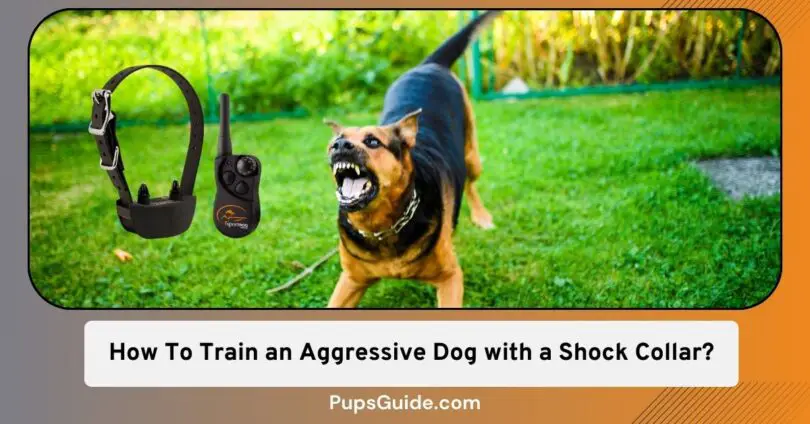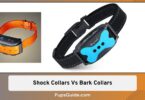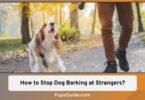So, your once-friendly furball has been channeling its inner grizzly bear, and you’re on the brink of needing a translator for all the growls.
Fear not, because today we’re diving into the world of shock collar training – a tool that, when used right, can help transform your furry tornado into a well-mannered pet.
Grab your doggy treat bag, and let’s embark on this adventure together!
Here’s How to Train an Aggressive Dog with a Shock Collar – 4 Basic Things to Consider Before Weekly Training
Consider the following 4 things before delving into the training regime. These are super important because they let you be prepared for what’s to come – your pet’s shenanigans.
1. Choose Wisely
Before you unleash the shock (pun intended), make sure you’ve got the right shock collar. Opt for one with adjustable settings. And trust me, you want this knob on low to start.
2. Get Your Timing Right
Timing is everything, especially in training. When using the shock collar, the zap should happen right when your dog is in the act of an undesirable behavior – not when they’re off daydreaming about squirrel chases.
Think of it like catching someone mid-sneeze instead of handing them a tissue afterward. The timing makes all the difference.
3. Start Low, Go Slow
We’re not cranking this up to “lightning bolt” mode right away. Start with the lowest shock setting. Observe your dog’s reaction and adjust accordingly.
4. Link the Shock to Behavior
Dogs are smart cookies, but they’re not mind readers. When the shock happens, your pup needs to connect the zap with their not-so-polite behavior. It’s like the cosmic karma of dog training – good behavior gets treats, and bad behavior gets a zap.
Day-to-Day Training Routine
Now that you’re armed with the basics, let’s dive into a day-to-day shock collar training routine for your feisty friend.
Day 1: The Introduction
Introduce the shock collar without any shock. Let your dog sniff it out – make it a “getting to know you” session. Positive vibes only – treats and pats on the back for just getting cozy with the collar.
Day 2-3: The Shock-Free Positive Reinforcement
Start using the shock collar with a little twist – no shocks yet. When your dog behaves like a saint, shower them with treats and praise. They’ll associate good behavior with rewards.
Day 4-7: Shock and Awe (but not too much)
Now, it’s showtime. When your pup is teetering on the edge of aggressive behavior, deliver a mild shock. Think of it like a stern, “Hey, cut it out!”
Week 2: Fine-Tuning the Shock Symphony
As the week progresses, fine-tune your shock collar orchestra. Adjust the intensity based on your dog’s reactions. We’re aiming for a training montage, not a shock-and-awe blockbuster.
Week 3-4: Consistency is Your Wingman
Consistency is the hero of this story. Be the Batman to your dog’s Gotham City – consistent, vigilant, and ready to deliver justice (or a mild shock) when needed.
Is There Any Link Between Aggression and Medical Conditions?
Before you jump to conclusions about your dog’s aggression, it’s crucial to understand that aggression can be a red flag for underlying medical issues. Keep a keen eye out for changes in behavior, like increased irritability, growling, or even nipping – these could be subtle cries for help.
Physical Pain and Aggression
Imagine waking up with a sore back – you’d probably be a bit grumpy too, right? Well, your dog is no different. Physical discomfort, whether from joint pain, dental issues, or any number of ailments, can trigger aggression. If your pup is feeling less than stellar, lashing out might be their way of saying that something isn’t right and you’re not paying attention.
Next time you notice a shift in your dog’s demeanor, consider a trip to the vet. Rule out any lurking health issues that might be causing them distress, and you could be on the road to a much happier and friendlier furball.
Can’t Hear You Over the Aggression
Dogs experiencing hearing loss might feel frustration and their response? You guessed it – aggression.
Hearing impairment can make your dog feel vulnerable and anxious, leading them to react defensively. Before you dismiss your dog as the resident grump, consider getting their hearing checked. A little understanding and some extra patience might be just what the doctor – or vet – ordered.
Vision Woes and Unwanted Growls
Just like us, dogs rely heavily on their vision to navigate the world around them. If your once confident and playful pup suddenly becomes standoffish or snarly, it could be a sign of vision problems. Diminished eyesight can make them feel insecure, prompting defensive behavior as a way to cope with their changing perception of the world.
A trip to the eye doctor – or vet, in this case – might reveal an issue that, once addressed, could bring your dog back to their selves.
The Hormone Havoc
Hormonal imbalances in dogs, whether due to aging, reproductive issues, or underlying health conditions, can be a major player in aggressive behavior. Your usually sweet pooch may be suddenly acting like a moody teenager. That’s when it’s the right time to check those hormone levels.
Your vet can run tests to identify any hormonal irregularities and recommend a plan to bring things back into balance. It’s like a canine spa day for their hormones – and your sanity.
Brain on the Fritz
Sometimes, aggression in dogs is linked to neurological issues that affect their brain function. Conditions like seizures, tumors, or cognitive dysfunction syndrome can alter your dog’s behavior and lead to uncharacteristic aggression.
When your dog’s aggression seems out of the ordinary and is accompanied by other worrisome signs like disorientation or unusual movements, consult your vet. They can conduct tests to assess your pup’s brain health and develop a plan to manage or treat any underlying issues.
Reasons for Aggression Beyond Medical
Underlying medical conditions are one thing, dog aggression could be the result of other things – foreseeable and otherwise.
1. Territorial Tiffs
Dogs also feel awkward about someone barging in on their territories unannounced. If your pup is feeling a bit possessive about their space – whether it’s a comfy bed or a sunny patch of grass in the backyard – they might unleash the growls and barks to defend what they see as rightfully theirs.
2. Social Snarls
Dogs, like humans, have their social circles. Your pup might have suddenly started giving the side-eye to other dogs or people, which could be the case of social anxiety or lack of proper socialization. Just imagine being at a party where you don’t know anyone – you might feel a bit uneasy too!
3. Fear Factor
Fear – it’s a powerful emotion that can turn even the friendliest dog into a bit of a scaredy-cat. Your pup can get aggressive when fear triggers such as thunderstorms, vacuum cleaners, or the dreaded bath time materialize.
4. Painful Past Experiences
Imagine meeting someone who reminds you of a not-so-pleasant past encounter – your guard might go up a bit, right? Dogs are no different. If your pup has had negative experiences, like abuse or trauma, they might exhibit aggression as a protective mechanism.
5. The Mighty Alpha Complex
Dogs are descendants of wolves, and in their world, there’s a hierarchy – the alpha dog rules the pack. If your pup thinks they’re the top dog in your household, they might exhibit aggressive behavior to assert dominance.
6. Guardian Instincts
Your dog might see themselves as the guardian of your house, especially if they perceive a potential threat. This protective instinct can manifest as aggression when they feel their pack – that’s you and your family – is under any form of attack.
Help your dog distinguish between actual threats and everyday occurrences. Training sessions that emphasize your role as the pack leader can reassure them that you’ve got things covered.
7. Frustration Overload
We all get a little cranky when things don’t go our way. Dogs are no exception. Frustration may build up, leading to aggressive outbursts, when your pup finds themselves in situations where they can’t express themselves or accomplish a task.
8. Unwanted Attention
Dogs, too, can get irritable when they feel overwhelmed by attention. That’s especially true for breeds such as Chihuahuas. When they are constantly bombarded with hugs, kisses, or petting when they’re not in the mood, they might resort to aggression to communicate their discomfort.
9. Unfulfilled Energy Quotient
Dogs thrive on physical activity, and when they don’t get enough exercise, it can result in restlessness and, you guessed it, aggression.
Shock Collar to Stop Bad Behaviour – Conclusion
So, there you go, dog enthusiasts – whether you’re delving into the reasons behind your pup’s aggression, exploring the potential medical links, or contemplating the use of a shock collar for training, the key takeaway is understanding and patience. Your dog isn’t just a pet; they’re a unique individual with their quirks and triggers.
By addressing the root causes, tailoring your approach, or using shock collars thoughtfully, you’re well on your way to transforming your furry companion into the best version of themselves.








Leave a Comment